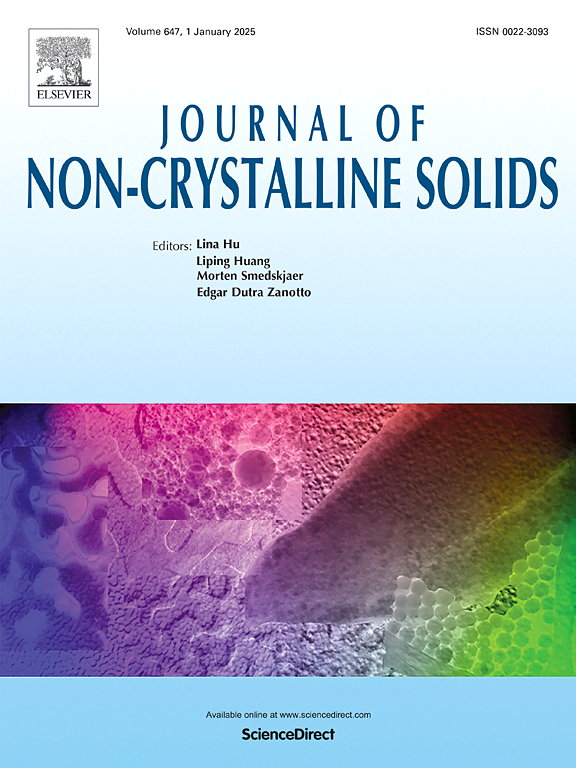Investigation on diffusion characteristics and performance of wide-spectrum chalcogenide GRIN with high refractive index
IF 3.2
3区 材料科学
Q1 MATERIALS SCIENCE, CERAMICS
引用次数: 0
Abstract
Gradient refractive index materials (GRINs) provide greater design freedom for aberration correction in wide-spectrum optical systems. In this paper, the GRINs with high refractive index and wide spectrum were successfully prepared by thermal diffusion of double-layer As50Se50-xTex chalcogenide glasses (ChGs). The GRINs have a refractive index spanning from 2.8 to 3.0 and a maximum refractive index difference (Δn) is 0.224. The spectral range with no significant attenuation of transmittance covers 1.5 to 18 µm. The diffusion characteristics of the GRINs were analyzed with a maximum diffusion depth of 400 μm. The values of the collision frequency factor and activation energy at different diffusion temperatures were obtained by utilizing Arrhenius law. The effect of temperature on the diffusion process was dominant over concentration. The axial refractive index distribution of GRINs is computed by converting the relationship between Te concentration and refractive index of the matrix glass. Furthermore, the dispersion characteristics of the GRINs were calculated. The Abbe number is negative, which is quite different from the dispersion characteristics presented by conventional infrared materials.
高折射率宽谱硫系GRIN扩散特性及性能研究
梯度折射率材料(GRINs)为宽光谱光学系统的像差校正提供了更大的设计自由度。本文采用双层As50Se50-xTex硫系玻璃(ChGs)热扩散法制备了高折射率、宽光谱的GRINs。GRINs的折射率从2.8到3.0不等,最大折射率差(Δn)为0.224。透射率无明显衰减的光谱范围为1.5 ~ 18µm。在最大扩散深度为400 μm时,对GRINs的扩散特性进行了分析。利用阿伦尼乌斯定律得到了不同扩散温度下的碰撞频率因子和活化能。温度对扩散过程的影响大于浓度。通过转换基体玻璃的Te浓度与折射率的关系,计算出了GRINs的轴向折射率分布。此外,还计算了GRINs的色散特性。阿贝数为负,这与传统红外材料的色散特性有很大不同。
本文章由计算机程序翻译,如有差异,请以英文原文为准。
求助全文
约1分钟内获得全文
求助全文
来源期刊

Journal of Non-crystalline Solids
工程技术-材料科学:硅酸盐
CiteScore
6.50
自引率
11.40%
发文量
576
审稿时长
35 days
期刊介绍:
The Journal of Non-Crystalline Solids publishes review articles, research papers, and Letters to the Editor on amorphous and glassy materials, including inorganic, organic, polymeric, hybrid and metallic systems. Papers on partially glassy materials, such as glass-ceramics and glass-matrix composites, and papers involving the liquid state are also included in so far as the properties of the liquid are relevant for the formation of the solid.
In all cases the papers must demonstrate both novelty and importance to the field, by way of significant advances in understanding or application of non-crystalline solids; in the case of Letters, a compelling case must also be made for expedited handling.
 求助内容:
求助内容: 应助结果提醒方式:
应助结果提醒方式:


